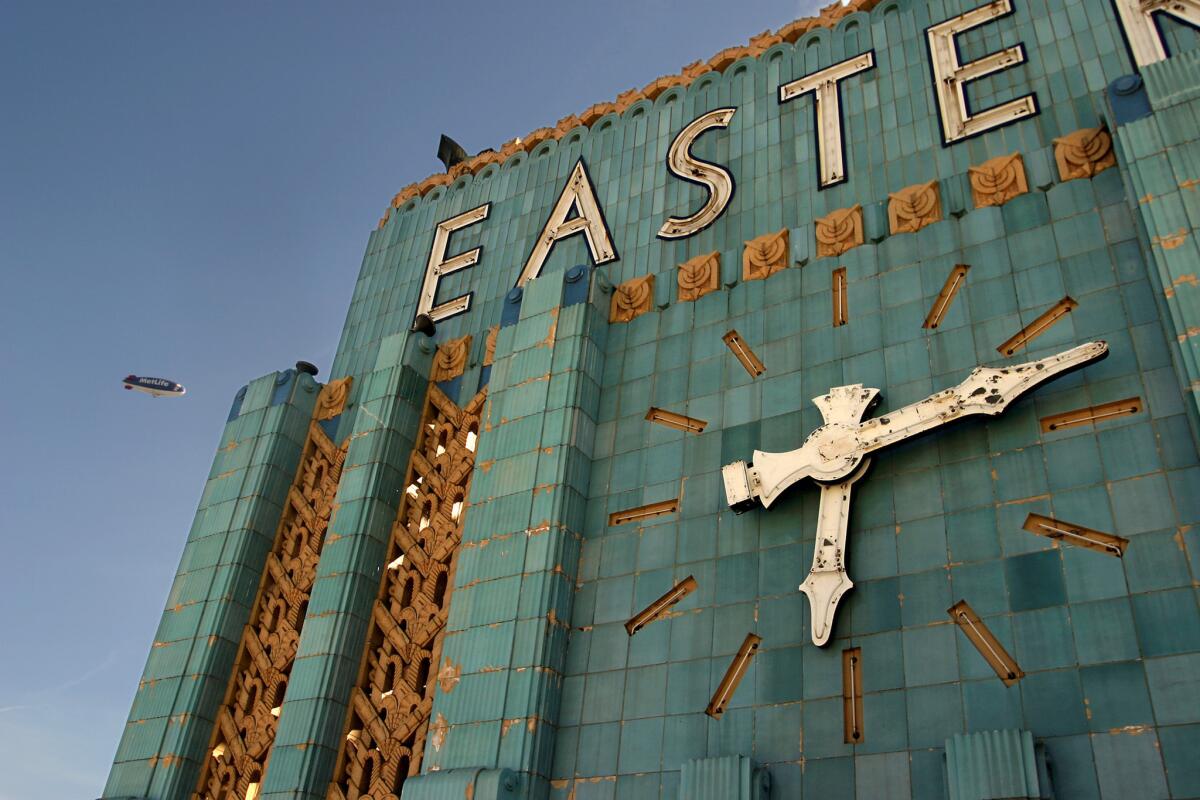Getty and city of L.A. launch website mapping historic places

The Eastern Columbia Building is listed on the National Register of Historic Places.
- Share via
The Getty Conservation Institute and the city of Los Angeles are expected to announce Tuesday the new website HistoricPlacesLA.org, the first digital portal designed to inventory, map and contextualize the city’s cultural heritage sites.
The interactive site allows users to search for places of historic importance by neighborhood or by categories, such as Modernism, the entertainment industry and pre-1900 L.A. The system contains about 25,000 resources, including 29 L.A. Historic Preservation Overlay Zones, 430 historic districts, 1,065 L.A. Historic Cultural Monuments and 300 places designated by the National Register of Historic Places.
ESSENTIAL ARTS & CULTURE NEWSLETTER >> Get great stories delivered to your inbox
HistoricPlacesLA also allows developers to identify potential road blocks, so they can amend plans or find ways to work adaptive reuse into a blueprint. The technology allows developers to draw boundaries on a map and see potential conflicts.
“Developers don’t like surprises,” Ken Bernstein, manager of the Office of Historic Resources, said in an interview. “HistoricPlacesLA gives developers and property owners critical upfront information that they can use in the planning process.”
The website is powered by a new open-source system called Arches created by the Getty Conservation Institute and the World Monuments Fund in New York.
“Arches is, without a doubt, the most advanced inventory and database system for historic resources that we’re aware of,” said Tim Whalen, director of the Getty institute, adding that the U.S. State Department has already made a grant to the University of Chicago to use Arches to identify and map places in Syria damaged by war.
In Los Angeles, the city gathered information through a program called Survey L.A., created with a city-matched grant of $2.5 million from the Getty institute. That grant was made in 2005, and the field surveys began in 2010. The surveys are 75% complete, Bernstein said.
“Our team has been making its way down every street in L.A. to identify potential historic resources,” Bernstein said. “The first step in protecting our city’s heritage is identifying what and where our historic buildings actually are.”
During a recent demonstration of the intuitive software, Getty Conservation Institute senior project manager Alison Dalgity traced a hypothetical Metro Purple Line on a map, and red dots representing cultural sites popped up. Clicking on those dots revealed details about the property in question, including when it was built and by whom, as well as details about notable residents or events of historical importance.
“You can search a neighborhood and map out a walking tour of interesting sites,” Dalgity said.
Hollywood location scouts might find the site helpful. Tourists too, Bernstein said.
Anyone interested in African American architecture, for example, can search for that. The surveying of the city was done according to a series of “historic context statements,” which put designated sites within intellectual and cultural frameworks including Mexican postwar development; lesbian, gay and transgender history; and the significance of the entertainment industry.
The Sugar Hill District is an example. It consists of 25 properties, bound by 22nd and 25th streets and Harvard and Hobart boulevards, that are significant for their association with African Americans’ quest to end deed restrictions that promoted racial segregation. Here in 1945, black homeowners hired prominent civil rights lawyer Loren Miller to sue for the right to own Sugar Hill homes.
“This is a living document,” Whalen said of the new site. “It’s a tool for the city of Los Angeles to utilize and exploit for many years to come.”
More to Read
The biggest entertainment stories
Get our big stories about Hollywood, film, television, music, arts, culture and more right in your inbox as soon as they publish.
You may occasionally receive promotional content from the Los Angeles Times.











